Types of Honey Bees
Every beekeeper wants to have the very best types of honey bees to go in his/her hive. But, how do you know what to choose? In truth, your choices will be somewhat limited due to availability in your region. In this article, you will learn about the different traits common to certain bee breeds. This will help you in your search for the best bees for your new hive.
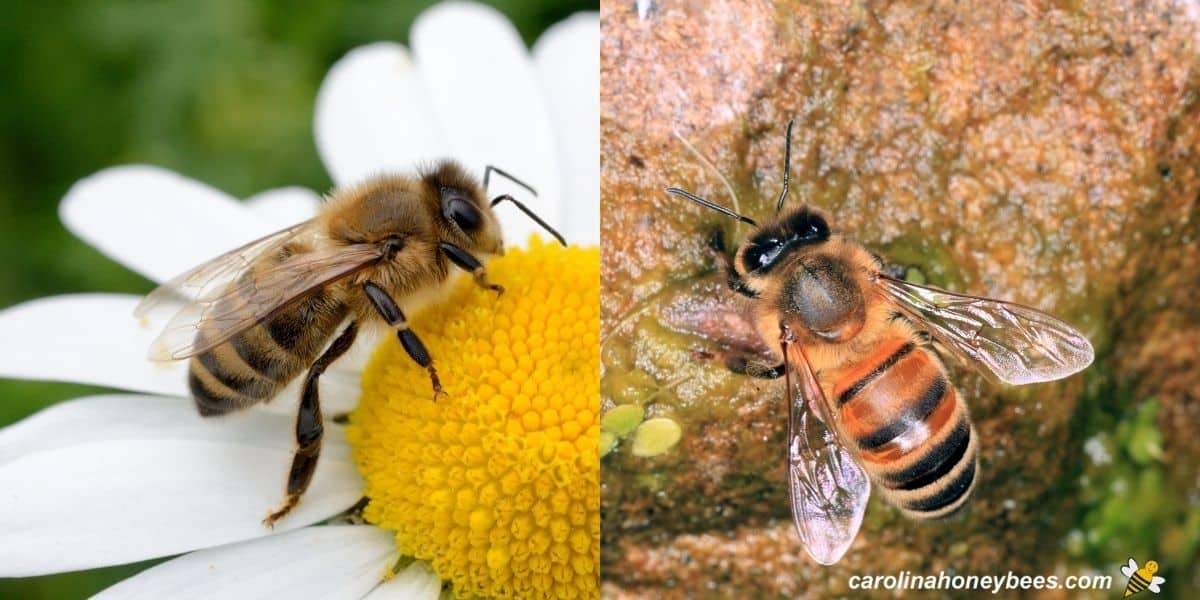
Honey bees. Seriously, how different can they be? Honestly, they are all very similar because they belong to the same family tree. However, there are “tendencies” within each breed that shows its special honey bee characteristics.
Races (Breeds) of Honey Bees
Unless you are really lucky or have a lot of money – your hives will not contain a pure breed of honey bees.
We often call our local bees a wonderful mix of mutts. A little of this and a little of that is a good way to describe the genetic makeup. They are a combination of different bee races and hybrid genetics present in your area.
Yet, any bee can have a concentration of genetic material and qualities from one specific type of honey bee. So, this is where must we begin – a look into the expected characteristics of each race.
Italian Honey Bee – Apis mellifera ligustica
The scientific name of a honey bee consists of the species name followed by the race. For Italians the proper name is “Apis mellifera ligustica” The last word “liqustica”- defines our bee as Italian.
The Italian honey bee is the most common race kept in managed hives. They are known for creating large populations and being good honey producers.
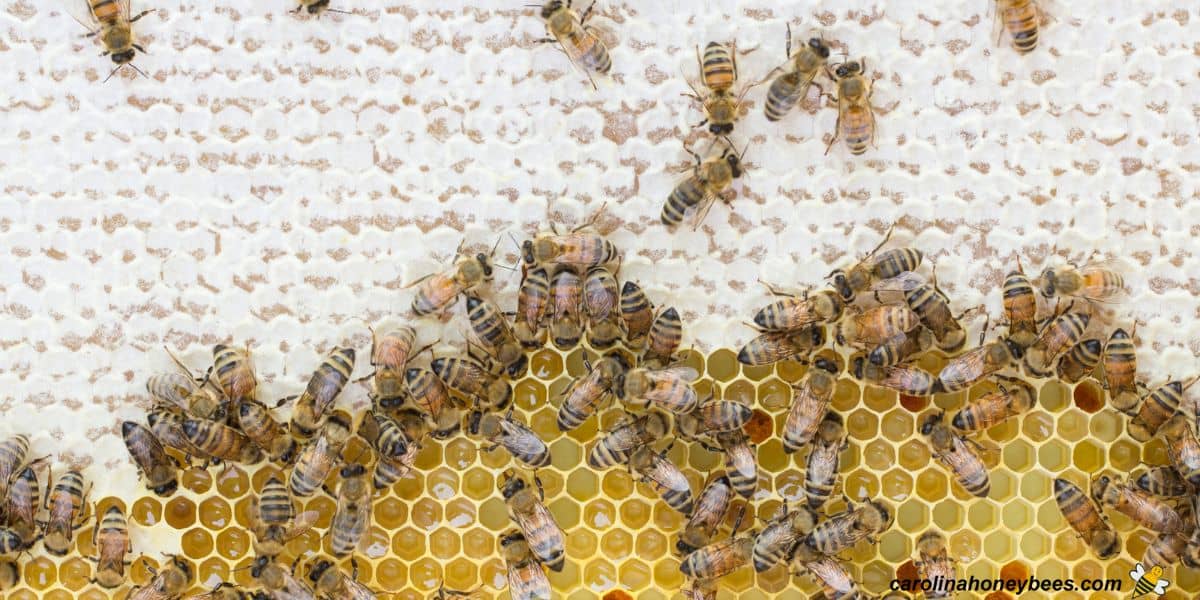
Italians are often golden in color but you can’t rely on to identify honey bees. Many other insects are golden and look similar.
Most Italian workers will be golden with various shades of black stripes. And, Italian Queens are often a shade darker than the workers.
We do enjoy looking at bee images and color may give us a glimpse into their possible genetic background.
Advantages
- climate adaptable
- calm temperament
- prolific – large colonies
- not as swarm prone as some
Italian bees originated in Italy (no surprise) and were brought to the US in the mid 1800’s. They are very adaptable to various climates but do not do best in extreme tropical settings.
Having a mild temperament, Italians have earned a favored place in beekeeping culture. A prolific bee, Italians tend to grow into large colonies and are good workers.
They are not as prone to swarming as some of the darker bees and tend to produce beautiful frames of white capped honey.
Disadvantages
Beautiful and productive, Italian bees are not without challenges.
- large winter population requires more food
- may be prone to robbing
- drifting can occur
- no great disease resistance
Their large winter populations require proper food stores. In regions with long Winter, starvation is a risk. The risk is greatest in late Winter/early Spring as the colony begins raising brood .
Italian bees are also prone to participate in bee robbing behavior – though all bee races will do the same.
Some strains of Italian bees are more prone to swarming during the productive season. They are sometimes more likely to drift to other beehives causing unequal populations.
Good robbing prevention practices and equalizing bee colony strength are useful management techniques. As well as, regular testing for varroa mites in all colonies.
Italians have not shown a marked resistance to disease and pests. It is hoped that other types of honey bees can be breed into the Italian line to improve mite resistance.
Carniolan Honey Bee – Apis mellifera carnica
Carniolan bees are very popular in beekeeping circles. They are a darker bee from the Yugoslavia region. Although, I prefer Italians, Carniolan “Carnis” are my second favorite.
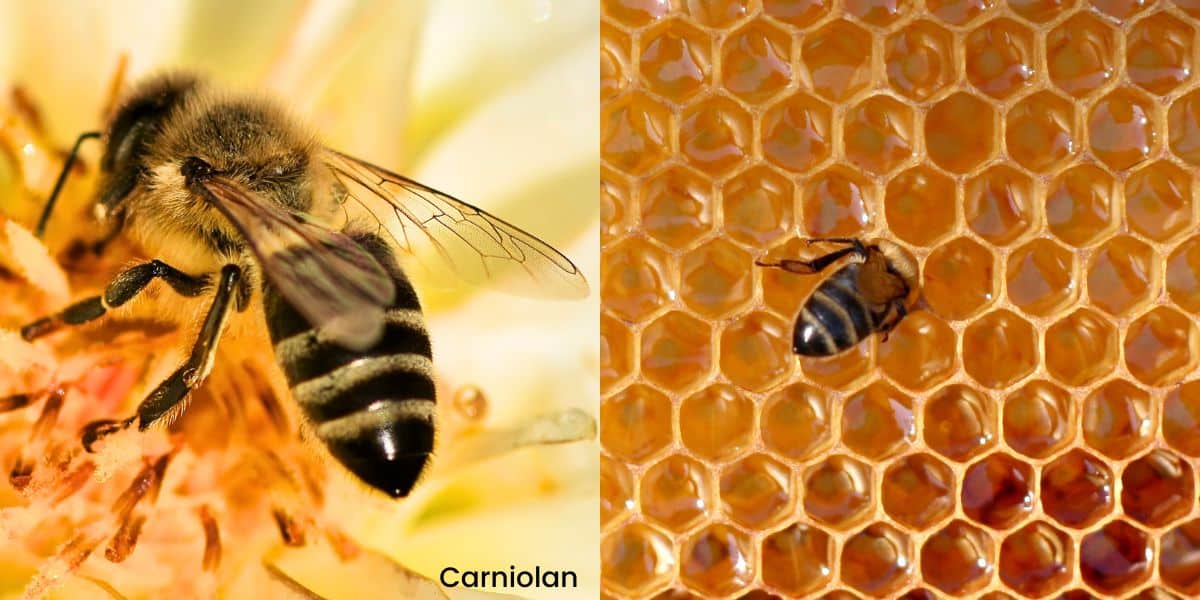
Because different races can inter-breed, I have used Carniolan Queens in my Italian hives in the past! This has become a common practice by package breeders too in a effort to have the best of several worlds (genetically speaking).
Advantages
- darker bees
- calm temperament
- forage well in cool weather
- better resource management
Carniolans are a sub species of bee developed in regions of Slovenia and the northern Balkans. A darker race of honey bee, a typical Carniolan honey bee will be a darkish grey with bright dark bands.
They have a calm, gentle temperament and are easy to manage. A good race of bee to keep in populated areas where aggressive behavior could be a problem.
Coming from a wet, cold region, Carniolans are more likely to forage on cool, wet days. This is a big advantage if you live in a cool damp climate.
Carnis over-winter with a smaller population than Italians. This gives a well-resourced hive a better chance of surviving Winter as a strong colony.
Disadvantages
Sorry, there is no perfect or best honey bee in the world – LOL. Even the beloved Carniolans have some issues.
- population explodes in Spring and make catch beekeeper off guard
- more likely to swarm on nectar flows
- darker bees with darker queen – may be more difficult to find
Carniolans build population quickly when natural nectar becomes available in early Spring. However, this can be a problem.
Carniolan bees are more prone to swarming once the nectar flow hits. You may have to watch them closely to make sure they have enough space.
Also, if your area has an early honey flow – will the bees build up strength early enough to take advantage of it?
Because they are darker, finding your queen in the hive can be more challenging – perhaps buying marked queens would be a good idea. Or, make plans to mark your own queen bees after they are accepted.
Caucasian- (Apis mellifera caucasica)
I have no personal experience with Caucasian bees as their distribution is more limited. They are grey to brown in color and originate from the Caucus region near the Caspian Sea.
Because, they are not as readily available as the other types of honey bees. You may not find a lot of this breed for sale.
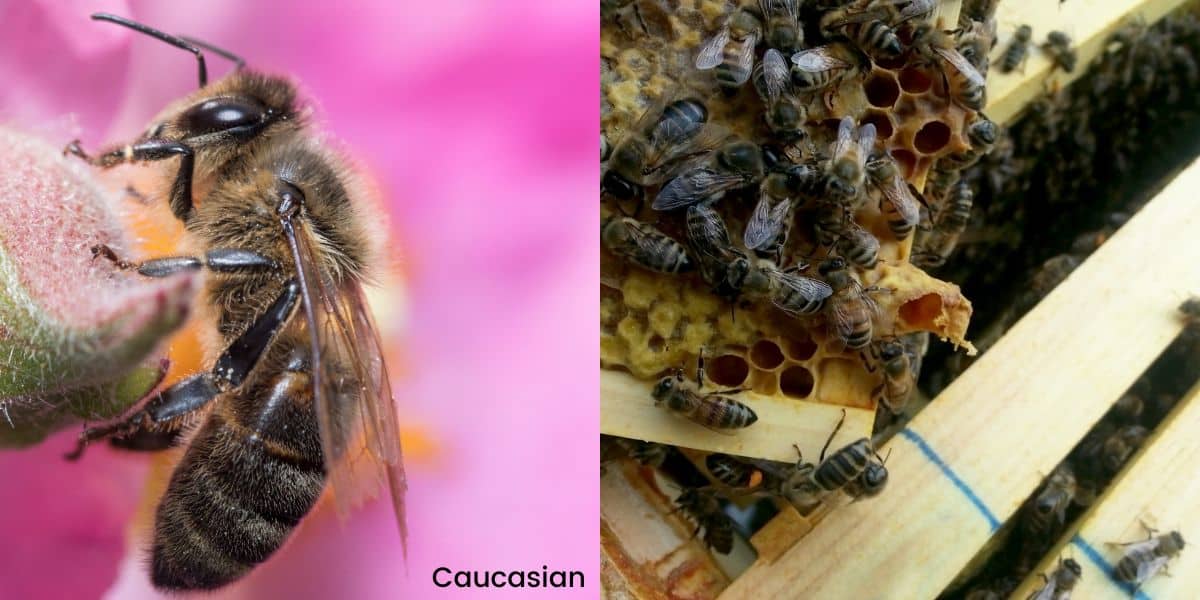
Advantages
This honey bee breed does have some favorable distinctions.
- able to forage on wider range of flowers
- forage in colder temperatures
- very gentle
Caucasians have a longer tongue (proboscis) than the other honey bees. This makes it possible for them to extract nectar from deeper blossoms-trumpet shaped flowers.
While they are generally not as productive as Italians, forager bees will work on colder days due to their region or origin.
They are considered by many to be the gentlest race. This is an important traits for many new beekeepers to consider.
Disadvantages
Like the others, you could face some challenges with Caucasian bees.
- abundant propolis
- more prone to nosema diseases
- difficult to find or buy
They make a lot of propolis. Propolis (bee glue) is used to seal cracks in the hive. But, sticky propolis also makes it difficult to inspect your beehive. I have one colony that must have some Caucasian genetics because it is really sticky inside the hive.
Caucasians have some resistance to European Foul Brood. However, they show a higher susceptibility to Nosema disease of honey bees.
Finding true Caucasians is difficult unless you are lucky enough to live in a region with Caucasian breeders.
Russian Honey Bees
Russian bees were imported into the United States from the Primorsky region of Russia. They are a strain of Apis mellifera – and not a separate race of honey bee. Usually black or dark brown in color, Russians are well suited for colder weather.
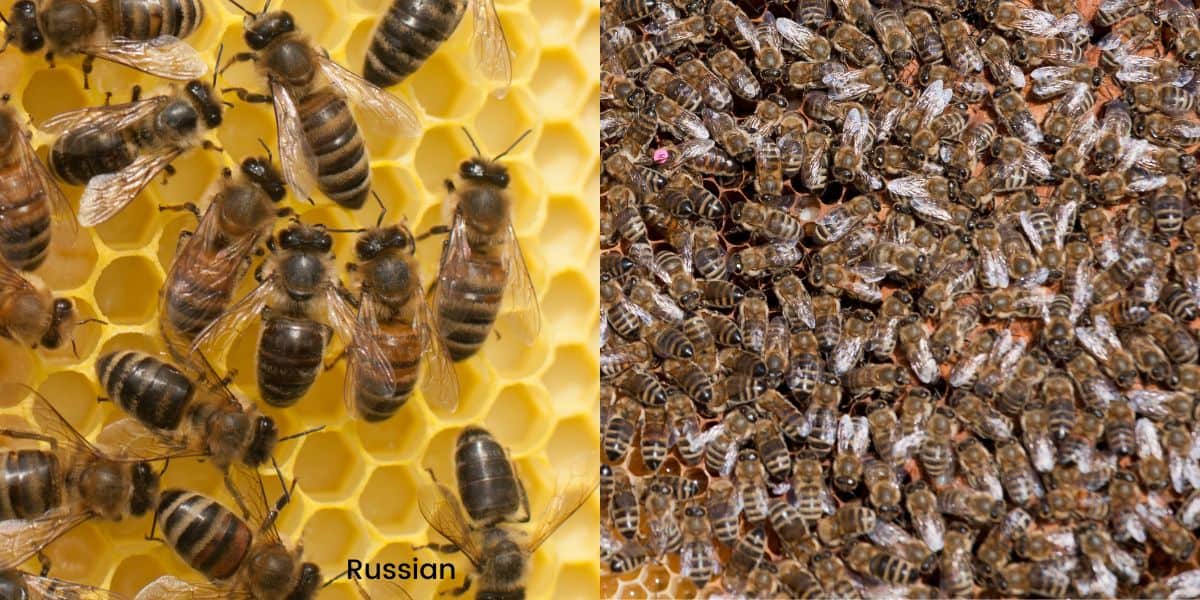
Advantages
- shows some varroa mite resistance
- overwinters with a smaller population
Imported into this county (USA) in 1997, researchers hoped to use them to breed more mite resistance bees. Bee breeders worked for several years on this program with some success – but not to the extent hoped for.
Like the Carniolans, Russian colonies overwinter with a smaller population – requiring less store food.
They are slower to build up in the spring, waiting for good nectar availability.
Disadvantages
- not “varroa mite proof”
- quick to build up – may swarm
- some are fussy or extra defensive
Even though they show some resistance, most of the Russian bees are not able to handle varroa mite infestations without beekeeper intervention. Conditions must still be monitored and treatment applied when needed.
Once natural nectar is available, they will explode in population. This tendency causes excessive swarming unless the beekeeper is observant.
Some beekeepers report that Russian colonies also tend to be a bit fussy and defensive. As with other hybrids, this characteristic becomes more likely when the colony is allowed to requeen the hive itself.
Buckfast Honey Bees
Buckfast bees are also not a pure breed. They are a mix of several different races and strains of bees. However, they were very popular in the beekeeping community in the past and some folks still prefer them.
Today’s Buckfast Bees are descended from a line of bees developed by Brother Adam. He was a monk at Buckfast Abby in England. (Brother Adam wished to create a new bee with all the best characteristics.)
Advantages
Admirable qualities include:
- good honey producer
- moderate spring growth – less prone to excessive swarming
- resistance to tracheal mites
Buckfast bees are valued as good honey producers. Colony population builds up moderately in the Spring. They are less prone to swarming that some types of honey bees.
Buckfast Bees show some resistance to tracheal mites. This type of mite is not as threatening as it has been in past years but problems still exist.
Disadvantages
- open breeding tends to result in more aggression
- limited availability
While pure breed Buckfast honey bees tend to be gentle, if allowed to re-queen themselves-the offspring can be aggressive.
This trait has caused them to fall out of favor with some beekeepers so it is not as easy to find them for sale as it once was.
Desirable Traits of Honey Bee Breeds
Once you look at what is available in the market, it is time to decide which honey bees to buy. You want to consider the characteristics most important to you.
Seriously, who would want to invest time and money in a bee that was known as a poor producer. But, production is only one factor to consider.
Most desirable traits beekeepers look for when choose a breed or type of honey bee:
- hardy – healthy
- productive
- temperament
It may be difficult to find the perfect kind of honey bee that meets all your desires. You must think about the factors that are most important to you as a beekeeper. And, availability will play a role in what you ultimately end up with.
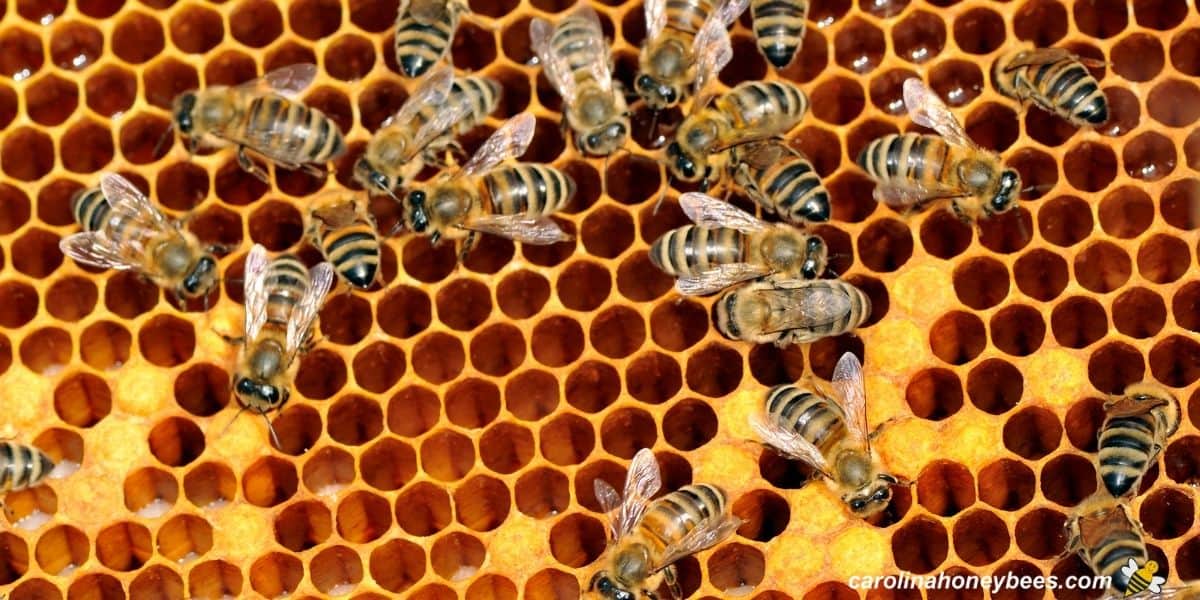
How Many Types of Honey Bees are There?
The colony consists of 3 kinds of bees in a hive (workers, drones and a queen). When we look at the family tree of bees – we consider races and species.
You will hear about different types of honey bees. At least 7 species of honey bees are found world-wide with many subspecies. Researchers often argue about this number.
Apis mellifera (or the European Honey bee – also called the Western Honey Bee) is the only species that lives here in the United States.
“Honey bees are not native to the United States. They were originally brought over by colonists coming to the new country.”
The different races of honey bees – also called breeds, hybrids or strains can interbreed with each other.
An easy way to understand this idea: a dog and a cat are 2 distinctly different “species” – they can not interbreed. But, 2 breeds of dogs (Lab and a Poodle) can mate and produce offspring.
FAQs
The first colonies were brought to American by settlers. This was a breed called the german black honey bees.
Any type of honey bee will sting when they feel threatened. The most commonly suggested-best bee for beginners are Italian honey bees that are know for good temperament and productivity
While some beekeepers proclaim the value of keeping “killer bees” – Africanized Honey bees – this is not the norm. Having a hive of these highly defensive and dangerous bees in your backyard is not a good idea and in some cases illegal.
Most beekeepers (like me) have “mutt bees”. A genetic mix of different races of bees.
Each race of bee has admirable characteristics. Italians are the most popular breed kept by beekeepers.
Finally
We are still looking for the perfect or best type of honey bee. It produces a lot of honey, has a gentle temperament, is resistant to pest and disease and doesn’t swarm unless we want it to. Let me know if you find some – you are willing to share, right?
Additional Resources

